Financial Management
VerifiedAdded on 2023/03/20
|9
|1489
|86
AI Summary
This document provides information on financial management, including topics such as investment calculations, bond valuation, dividend analysis, and project evaluation. It also includes portfolio analysis and the concept of time value of money.
Contribute Materials
Your contribution can guide someone’s learning journey. Share your
documents today.

Running head: FINANCIAL MANAGEMENT
Financial Management
Name of the Student:
Name of the University:
Author’s Note:
Financial Management
Name of the Student:
Name of the University:
Author’s Note:
Secure Best Marks with AI Grader
Need help grading? Try our AI Grader for instant feedback on your assignments.
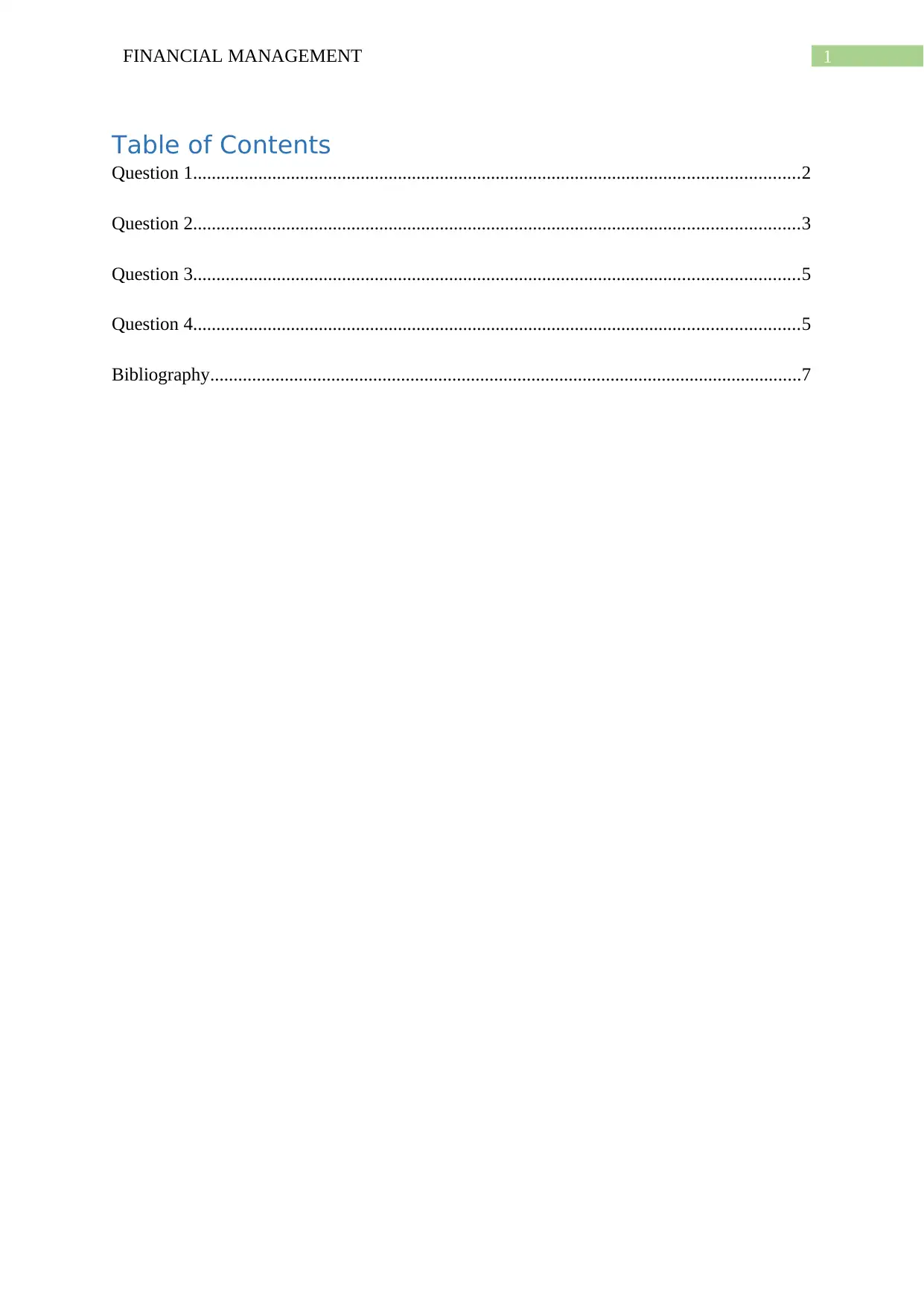
1FINANCIAL MANAGEMENT
Table of Contents
Question 1..................................................................................................................................2
Question 2..................................................................................................................................3
Question 3..................................................................................................................................5
Question 4..................................................................................................................................5
Bibliography...............................................................................................................................7
Table of Contents
Question 1..................................................................................................................................2
Question 2..................................................................................................................................3
Question 3..................................................................................................................................5
Question 4..................................................................................................................................5
Bibliography...............................................................................................................................7
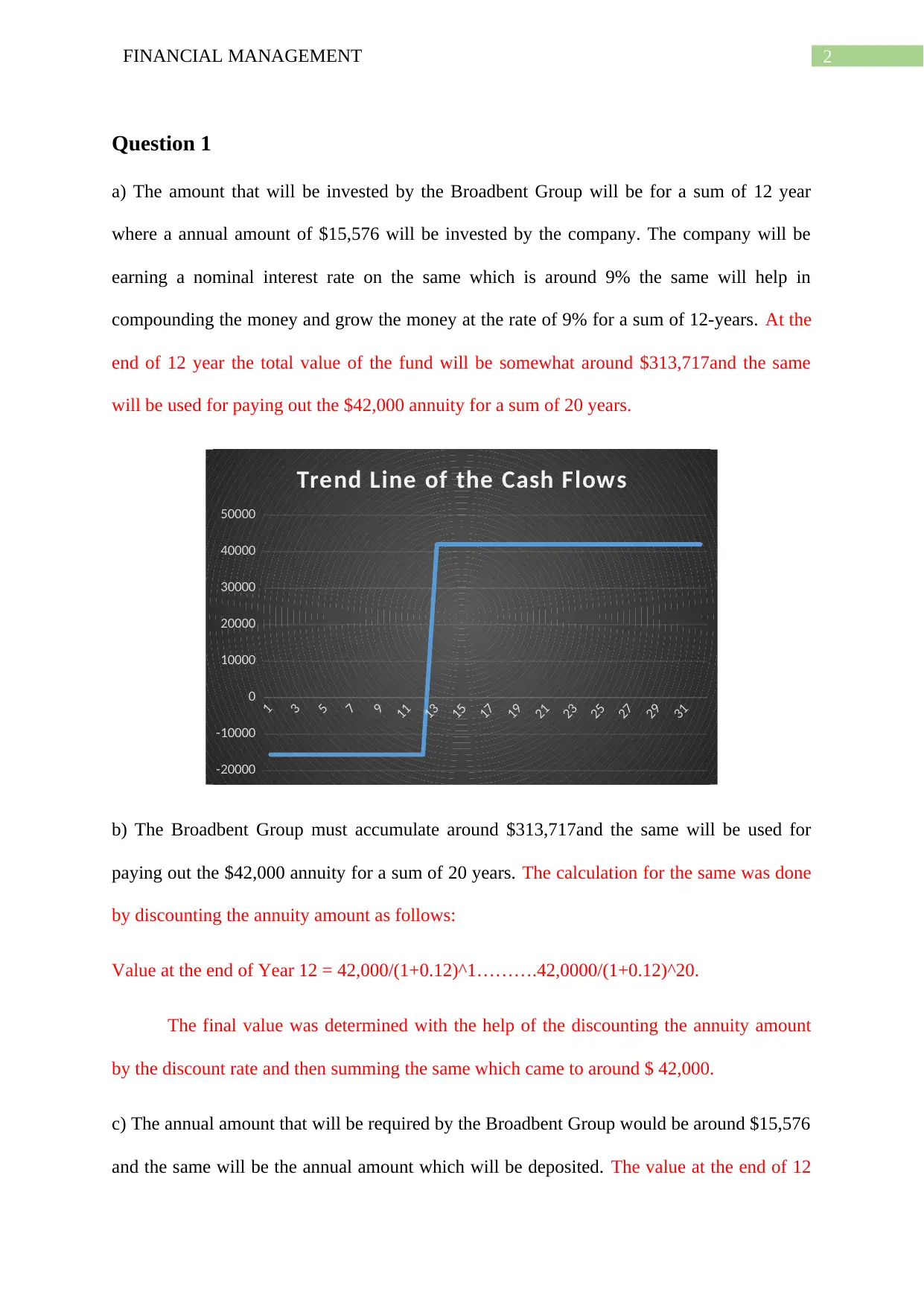
2FINANCIAL MANAGEMENT
Question 1
a) The amount that will be invested by the Broadbent Group will be for a sum of 12 year
where a annual amount of $15,576 will be invested by the company. The company will be
earning a nominal interest rate on the same which is around 9% the same will help in
compounding the money and grow the money at the rate of 9% for a sum of 12-years. At the
end of 12 year the total value of the fund will be somewhat around $313,717and the same
will be used for paying out the $42,000 annuity for a sum of 20 years.
1
3
5
7
9
11
13
15
17
19
21
23
25
27
29
31
-20000
-10000
0
10000
20000
30000
40000
50000
Trend Line of the Cash Flows
b) The Broadbent Group must accumulate around $313,717and the same will be used for
paying out the $42,000 annuity for a sum of 20 years. The calculation for the same was done
by discounting the annuity amount as follows:
Value at the end of Year 12 = 42,000/(1+0.12)^1……….42,0000/(1+0.12)^20.
The final value was determined with the help of the discounting the annuity amount
by the discount rate and then summing the same which came to around $ 42,000.
c) The annual amount that will be required by the Broadbent Group would be around $15,576
and the same will be the annual amount which will be deposited. The value at the end of 12
Question 1
a) The amount that will be invested by the Broadbent Group will be for a sum of 12 year
where a annual amount of $15,576 will be invested by the company. The company will be
earning a nominal interest rate on the same which is around 9% the same will help in
compounding the money and grow the money at the rate of 9% for a sum of 12-years. At the
end of 12 year the total value of the fund will be somewhat around $313,717and the same
will be used for paying out the $42,000 annuity for a sum of 20 years.
1
3
5
7
9
11
13
15
17
19
21
23
25
27
29
31
-20000
-10000
0
10000
20000
30000
40000
50000
Trend Line of the Cash Flows
b) The Broadbent Group must accumulate around $313,717and the same will be used for
paying out the $42,000 annuity for a sum of 20 years. The calculation for the same was done
by discounting the annuity amount as follows:
Value at the end of Year 12 = 42,000/(1+0.12)^1……….42,0000/(1+0.12)^20.
The final value was determined with the help of the discounting the annuity amount
by the discount rate and then summing the same which came to around $ 42,000.
c) The annual amount that will be required by the Broadbent Group would be around $15,576
and the same will be the annual amount which will be deposited. The value at the end of 12
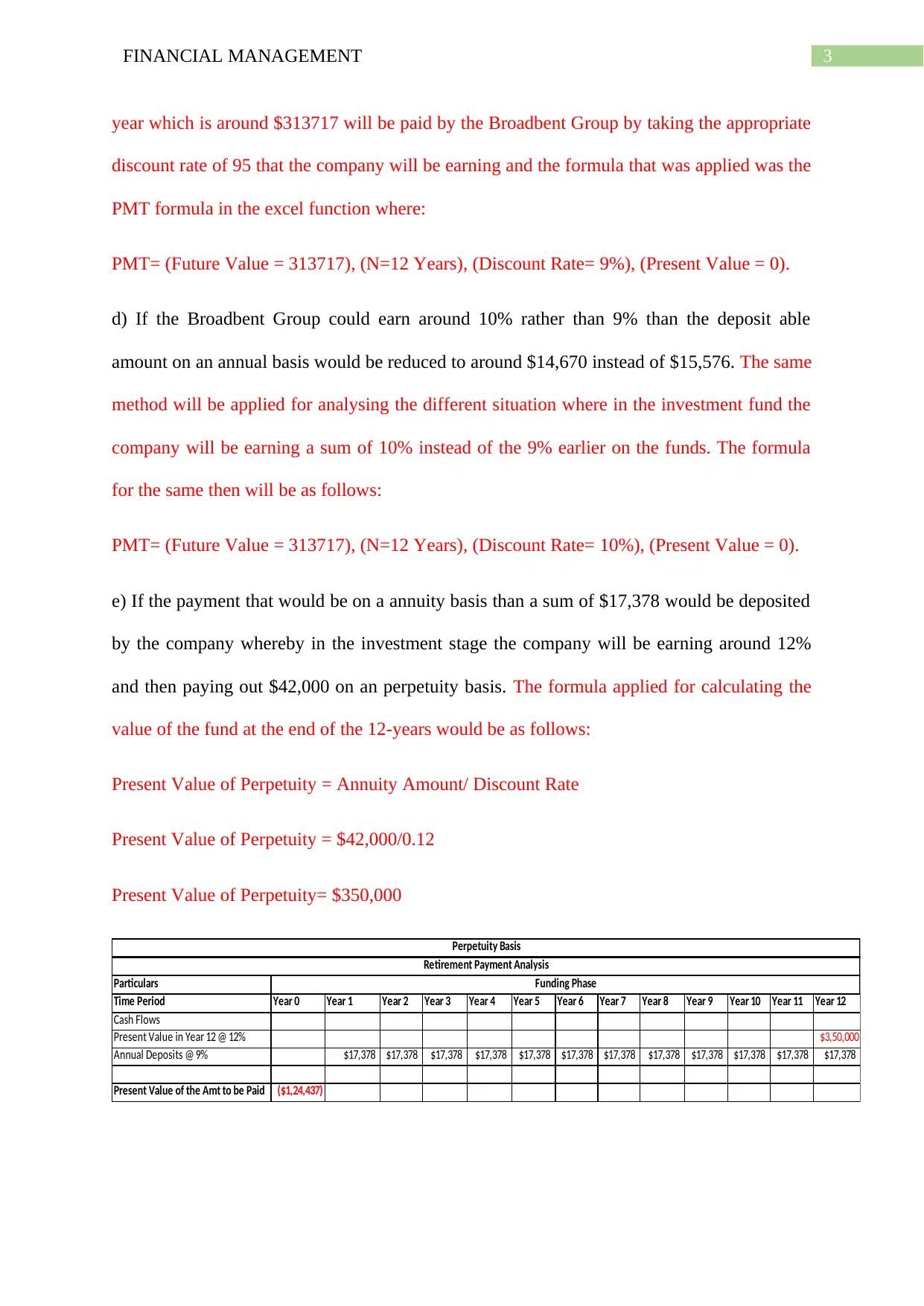
3FINANCIAL MANAGEMENT
year which is around $313717 will be paid by the Broadbent Group by taking the appropriate
discount rate of 95 that the company will be earning and the formula that was applied was the
PMT formula in the excel function where:
PMT= (Future Value = 313717), (N=12 Years), (Discount Rate= 9%), (Present Value = 0).
d) If the Broadbent Group could earn around 10% rather than 9% than the deposit able
amount on an annual basis would be reduced to around $14,670 instead of $15,576. The same
method will be applied for analysing the different situation where in the investment fund the
company will be earning a sum of 10% instead of the 9% earlier on the funds. The formula
for the same then will be as follows:
PMT= (Future Value = 313717), (N=12 Years), (Discount Rate= 10%), (Present Value = 0).
e) If the payment that would be on a annuity basis than a sum of $17,378 would be deposited
by the company whereby in the investment stage the company will be earning around 12%
and then paying out $42,000 on an perpetuity basis. The formula applied for calculating the
value of the fund at the end of the 12-years would be as follows:
Present Value of Perpetuity = Annuity Amount/ Discount Rate
Present Value of Perpetuity = $42,000/0.12
Present Value of Perpetuity= $350,000
Particulars
Time Period Year 0 Year 1 Year 2 Year 3 Year 4 Year 5 Year 6 Year 7 Year 8 Year 9 Year 10 Year 11 Year 12
Cash Flows
Present Value in Year 12 @ 12% $3,50,000
Annual Deposits @ 9% $17,378 $17,378 $17,378 $17,378 $17,378 $17,378 $17,378 $17,378 $17,378 $17,378 $17,378 $17,378
Present Value of the Amt to be Paid ($1,24,437)
Funding Phase
Retirement Payment Analysis
Perpetuity Basis
year which is around $313717 will be paid by the Broadbent Group by taking the appropriate
discount rate of 95 that the company will be earning and the formula that was applied was the
PMT formula in the excel function where:
PMT= (Future Value = 313717), (N=12 Years), (Discount Rate= 9%), (Present Value = 0).
d) If the Broadbent Group could earn around 10% rather than 9% than the deposit able
amount on an annual basis would be reduced to around $14,670 instead of $15,576. The same
method will be applied for analysing the different situation where in the investment fund the
company will be earning a sum of 10% instead of the 9% earlier on the funds. The formula
for the same then will be as follows:
PMT= (Future Value = 313717), (N=12 Years), (Discount Rate= 10%), (Present Value = 0).
e) If the payment that would be on a annuity basis than a sum of $17,378 would be deposited
by the company whereby in the investment stage the company will be earning around 12%
and then paying out $42,000 on an perpetuity basis. The formula applied for calculating the
value of the fund at the end of the 12-years would be as follows:
Present Value of Perpetuity = Annuity Amount/ Discount Rate
Present Value of Perpetuity = $42,000/0.12
Present Value of Perpetuity= $350,000
Particulars
Time Period Year 0 Year 1 Year 2 Year 3 Year 4 Year 5 Year 6 Year 7 Year 8 Year 9 Year 10 Year 11 Year 12
Cash Flows
Present Value in Year 12 @ 12% $3,50,000
Annual Deposits @ 9% $17,378 $17,378 $17,378 $17,378 $17,378 $17,378 $17,378 $17,378 $17,378 $17,378 $17,378 $17,378
Present Value of the Amt to be Paid ($1,24,437)
Funding Phase
Retirement Payment Analysis
Perpetuity Basis
Secure Best Marks with AI Grader
Need help grading? Try our AI Grader for instant feedback on your assignments.
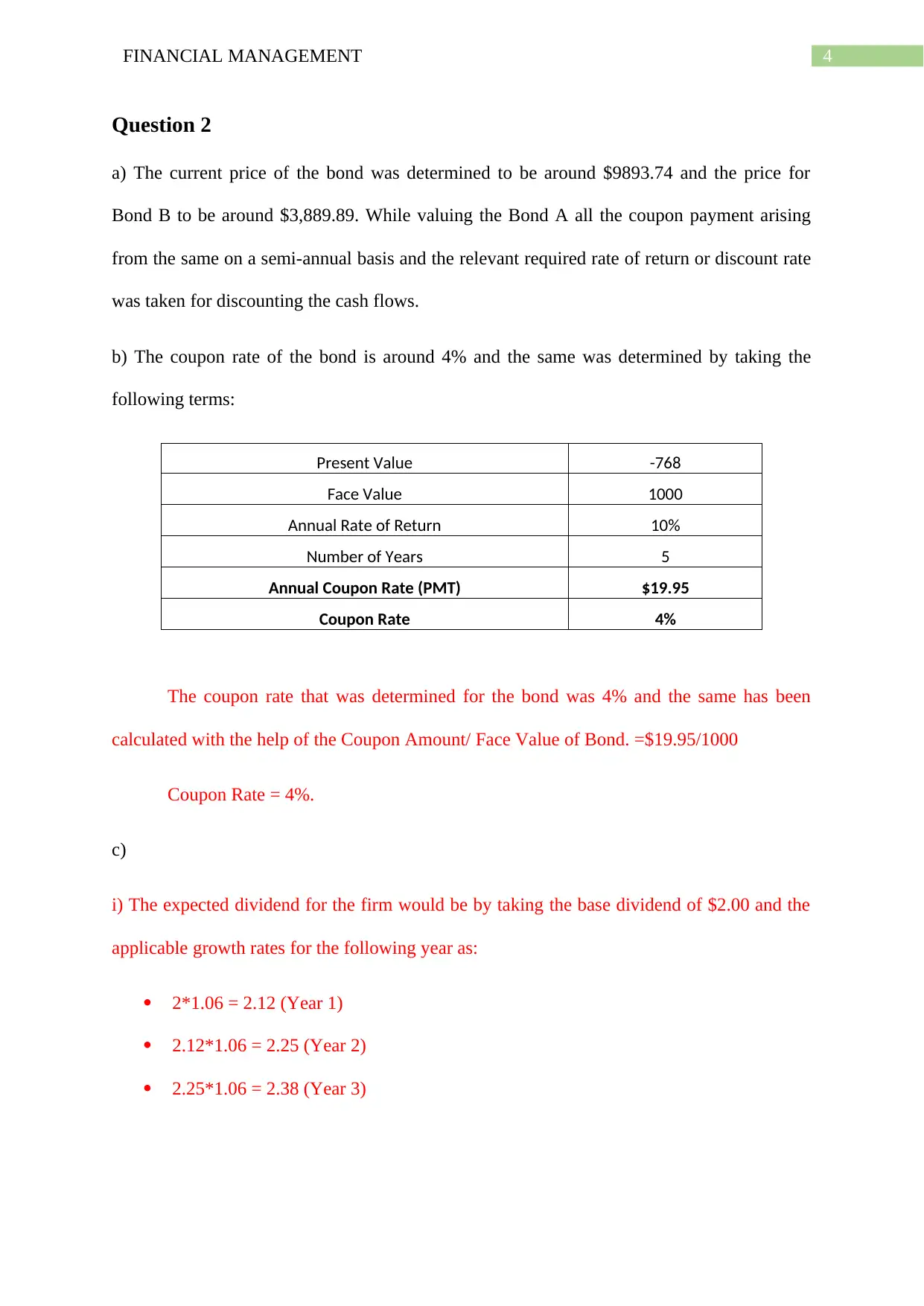
4FINANCIAL MANAGEMENT
Question 2
a) The current price of the bond was determined to be around $9893.74 and the price for
Bond B to be around $3,889.89. While valuing the Bond A all the coupon payment arising
from the same on a semi-annual basis and the relevant required rate of return or discount rate
was taken for discounting the cash flows.
b) The coupon rate of the bond is around 4% and the same was determined by taking the
following terms:
Present Value -768
Face Value 1000
Annual Rate of Return 10%
Number of Years 5
Annual Coupon Rate (PMT) $19.95
Coupon Rate 4%
The coupon rate that was determined for the bond was 4% and the same has been
calculated with the help of the Coupon Amount/ Face Value of Bond. =$19.95/1000
Coupon Rate = 4%.
c)
i) The expected dividend for the firm would be by taking the base dividend of $2.00 and the
applicable growth rates for the following year as:
2*1.06 = 2.12 (Year 1)
2.12*1.06 = 2.25 (Year 2)
2.25*1.06 = 2.38 (Year 3)
Question 2
a) The current price of the bond was determined to be around $9893.74 and the price for
Bond B to be around $3,889.89. While valuing the Bond A all the coupon payment arising
from the same on a semi-annual basis and the relevant required rate of return or discount rate
was taken for discounting the cash flows.
b) The coupon rate of the bond is around 4% and the same was determined by taking the
following terms:
Present Value -768
Face Value 1000
Annual Rate of Return 10%
Number of Years 5
Annual Coupon Rate (PMT) $19.95
Coupon Rate 4%
The coupon rate that was determined for the bond was 4% and the same has been
calculated with the help of the Coupon Amount/ Face Value of Bond. =$19.95/1000
Coupon Rate = 4%.
c)
i) The expected dividend for the firm would be by taking the base dividend of $2.00 and the
applicable growth rates for the following year as:
2*1.06 = 2.12 (Year 1)
2.12*1.06 = 2.25 (Year 2)
2.25*1.06 = 2.38 (Year 3)
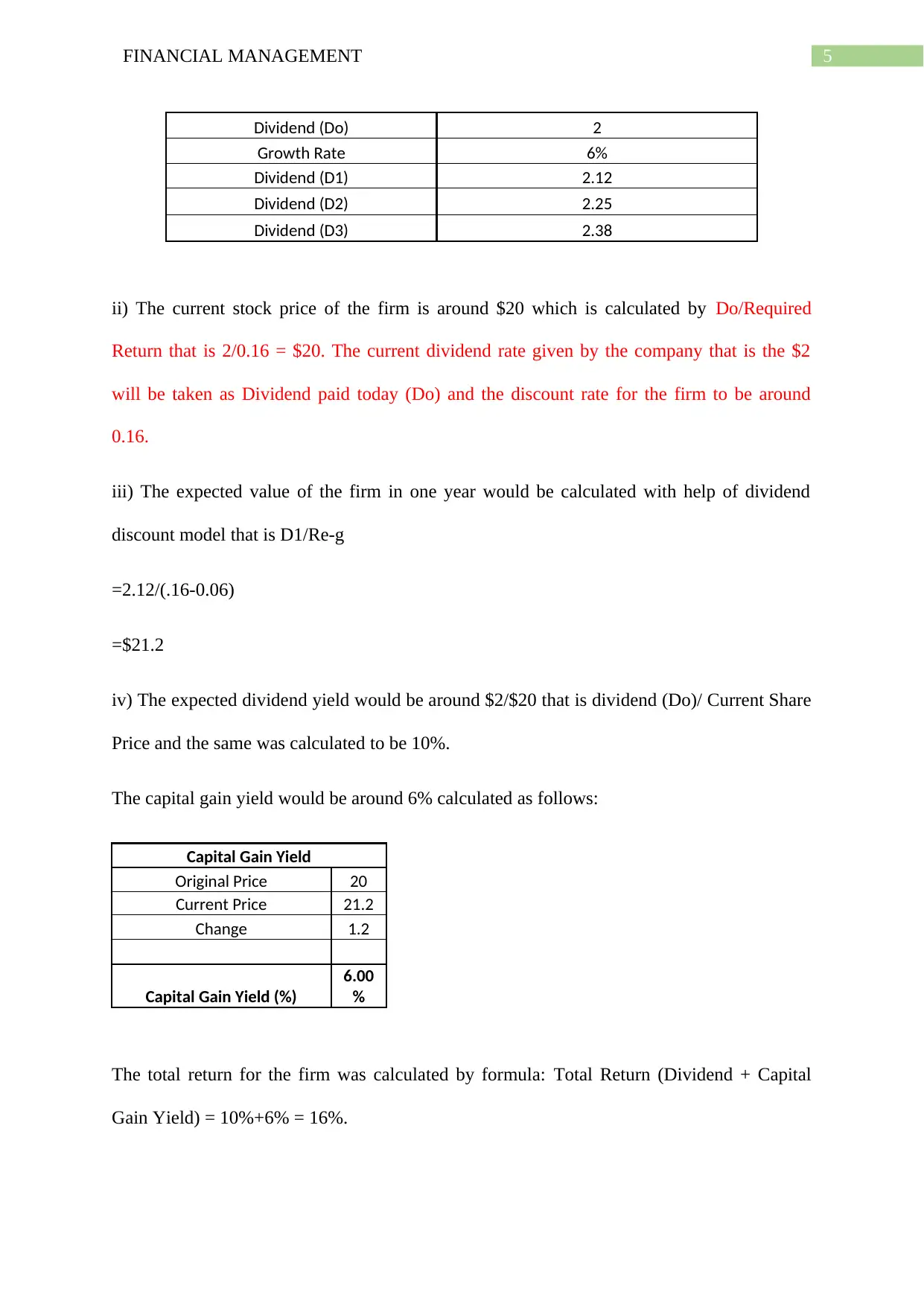
5FINANCIAL MANAGEMENT
Dividend (Do) 2
Growth Rate 6%
Dividend (D1) 2.12
Dividend (D2) 2.25
Dividend (D3) 2.38
ii) The current stock price of the firm is around $20 which is calculated by Do/Required
Return that is 2/0.16 = $20. The current dividend rate given by the company that is the $2
will be taken as Dividend paid today (Do) and the discount rate for the firm to be around
0.16.
iii) The expected value of the firm in one year would be calculated with help of dividend
discount model that is D1/Re-g
=2.12/(.16-0.06)
=$21.2
iv) The expected dividend yield would be around $2/$20 that is dividend (Do)/ Current Share
Price and the same was calculated to be 10%.
The capital gain yield would be around 6% calculated as follows:
Capital Gain Yield
Original Price 20
Current Price 21.2
Change 1.2
Capital Gain Yield (%)
6.00
%
The total return for the firm was calculated by formula: Total Return (Dividend + Capital
Gain Yield) = 10%+6% = 16%.
Dividend (Do) 2
Growth Rate 6%
Dividend (D1) 2.12
Dividend (D2) 2.25
Dividend (D3) 2.38
ii) The current stock price of the firm is around $20 which is calculated by Do/Required
Return that is 2/0.16 = $20. The current dividend rate given by the company that is the $2
will be taken as Dividend paid today (Do) and the discount rate for the firm to be around
0.16.
iii) The expected value of the firm in one year would be calculated with help of dividend
discount model that is D1/Re-g
=2.12/(.16-0.06)
=$21.2
iv) The expected dividend yield would be around $2/$20 that is dividend (Do)/ Current Share
Price and the same was calculated to be 10%.
The capital gain yield would be around 6% calculated as follows:
Capital Gain Yield
Original Price 20
Current Price 21.2
Change 1.2
Capital Gain Yield (%)
6.00
%
The total return for the firm was calculated by formula: Total Return (Dividend + Capital
Gain Yield) = 10%+6% = 16%.
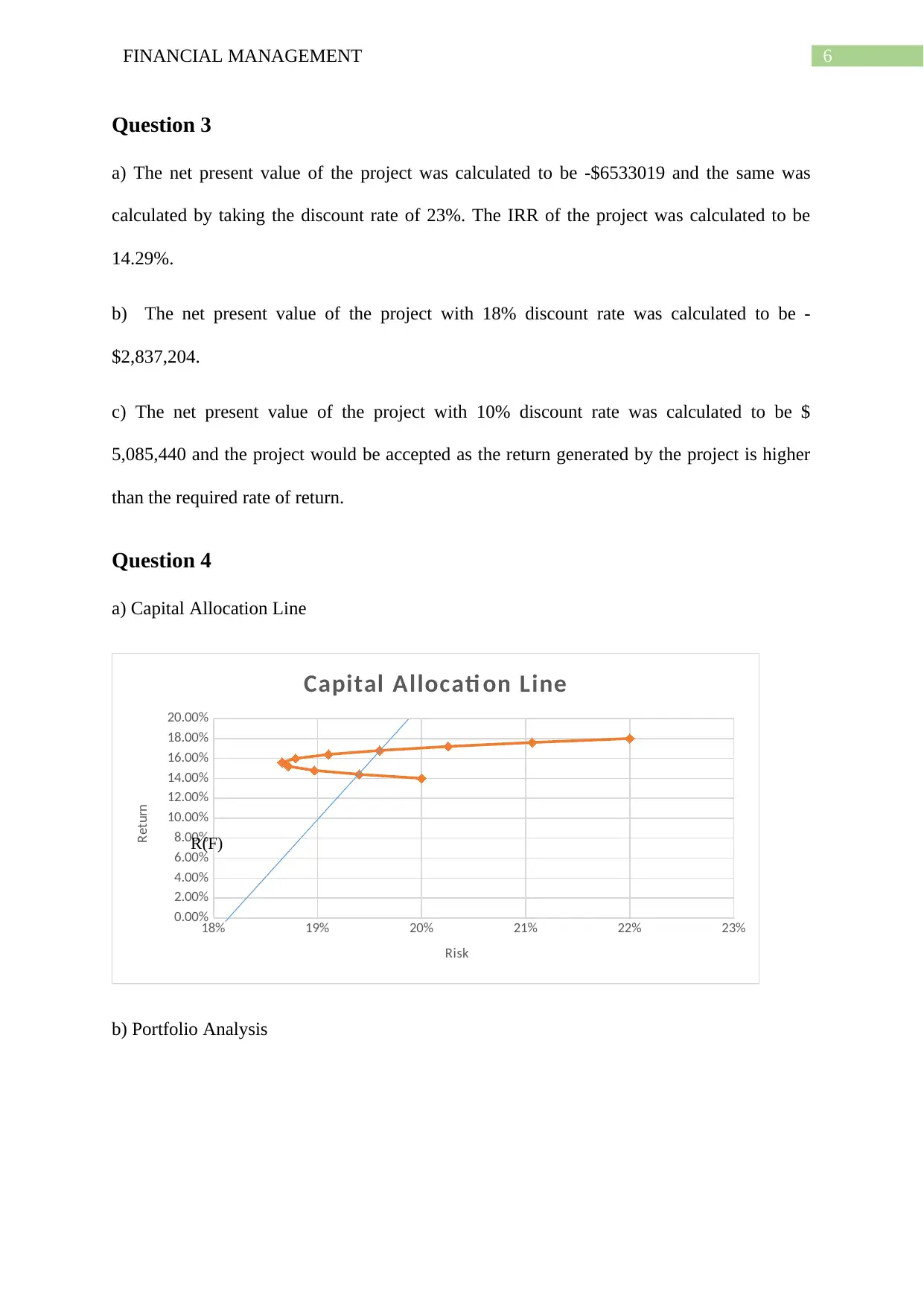
6FINANCIAL MANAGEMENT
Question 3
a) The net present value of the project was calculated to be -$6533019 and the same was
calculated by taking the discount rate of 23%. The IRR of the project was calculated to be
14.29%.
b) The net present value of the project with 18% discount rate was calculated to be -
$2,837,204.
c) The net present value of the project with 10% discount rate was calculated to be $
5,085,440 and the project would be accepted as the return generated by the project is higher
than the required rate of return.
Question 4
a) Capital Allocation Line
18% 19% 20% 21% 22% 23%
0.00%
2.00%
4.00%
6.00%
8.00%
10.00%
12.00%
14.00%
16.00%
18.00%
20.00%
Capital Allocati on Line
Risk
Return
R(F)
b) Portfolio Analysis
Question 3
a) The net present value of the project was calculated to be -$6533019 and the same was
calculated by taking the discount rate of 23%. The IRR of the project was calculated to be
14.29%.
b) The net present value of the project with 18% discount rate was calculated to be -
$2,837,204.
c) The net present value of the project with 10% discount rate was calculated to be $
5,085,440 and the project would be accepted as the return generated by the project is higher
than the required rate of return.
Question 4
a) Capital Allocation Line
18% 19% 20% 21% 22% 23%
0.00%
2.00%
4.00%
6.00%
8.00%
10.00%
12.00%
14.00%
16.00%
18.00%
20.00%
Capital Allocati on Line
Risk
Return
R(F)
b) Portfolio Analysis
Paraphrase This Document
Need a fresh take? Get an instant paraphrase of this document with our AI Paraphraser
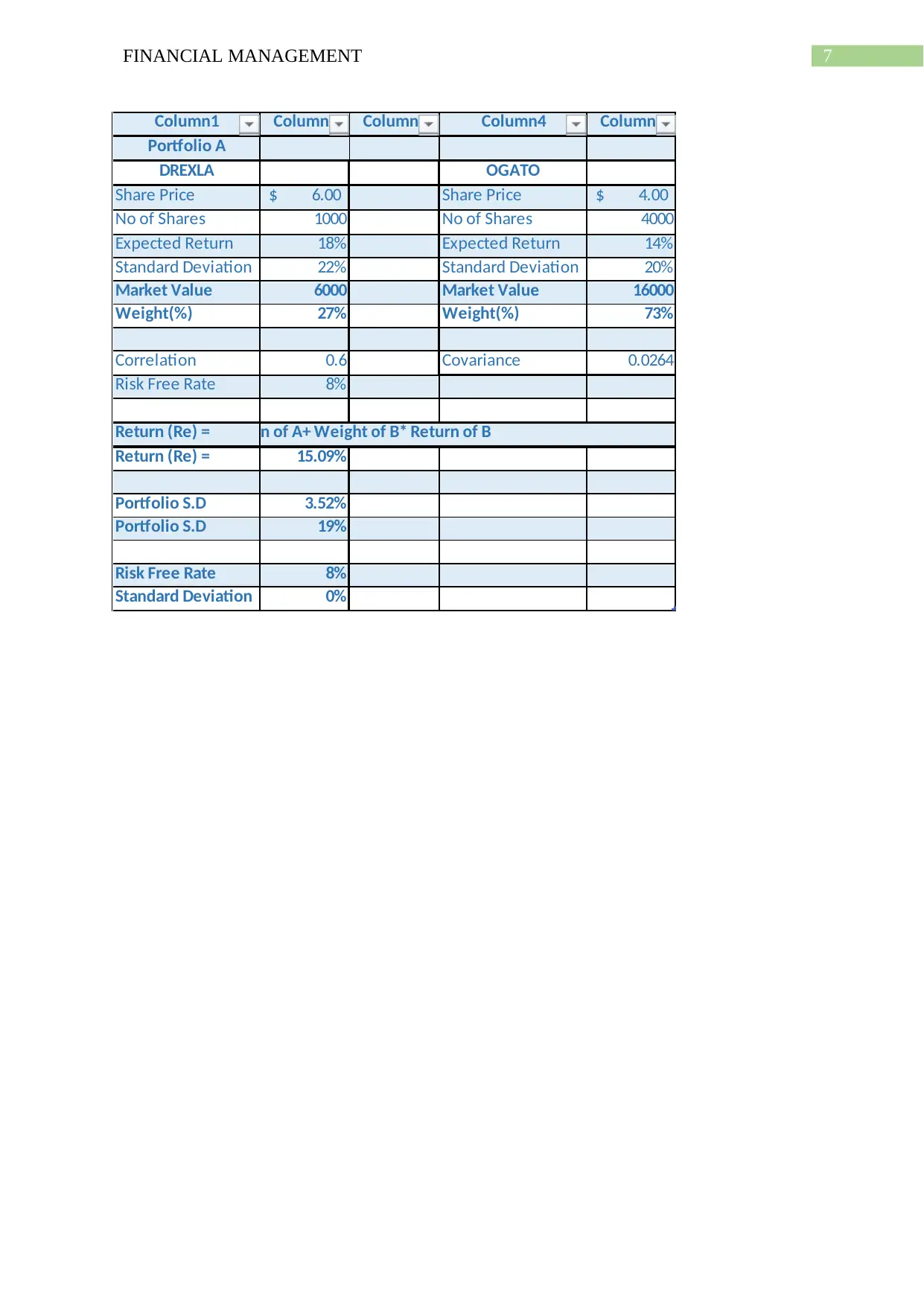
7FINANCIAL MANAGEMENT
Column1 Column2 Column3 Column4 Column5
Portfolio A
DREXLA OGATO
Share Price 6.00$ Share Price 4.00$
No of Shares 1000 No of Shares 4000
Expected Return 18% Expected Return 14%
Standard Deviation 22% Standard Deviation 20%
Market Value 6000 Market Value 16000
Weight(%) 27% Weight(%) 73%
Correlation 0.6 Covariance 0.0264
Risk Free Rate 8%
Return (Re) =Weight of A * Return of A+ Weight of B* Return of B
Return (Re) = 15.09%
Portfolio S.D 3.52%
Portfolio S.D 19%
Risk Free Rate 8%
Standard Deviation 0%
Column1 Column2 Column3 Column4 Column5
Portfolio A
DREXLA OGATO
Share Price 6.00$ Share Price 4.00$
No of Shares 1000 No of Shares 4000
Expected Return 18% Expected Return 14%
Standard Deviation 22% Standard Deviation 20%
Market Value 6000 Market Value 16000
Weight(%) 27% Weight(%) 73%
Correlation 0.6 Covariance 0.0264
Risk Free Rate 8%
Return (Re) =Weight of A * Return of A+ Weight of B* Return of B
Return (Re) = 15.09%
Portfolio S.D 3.52%
Portfolio S.D 19%
Risk Free Rate 8%
Standard Deviation 0%
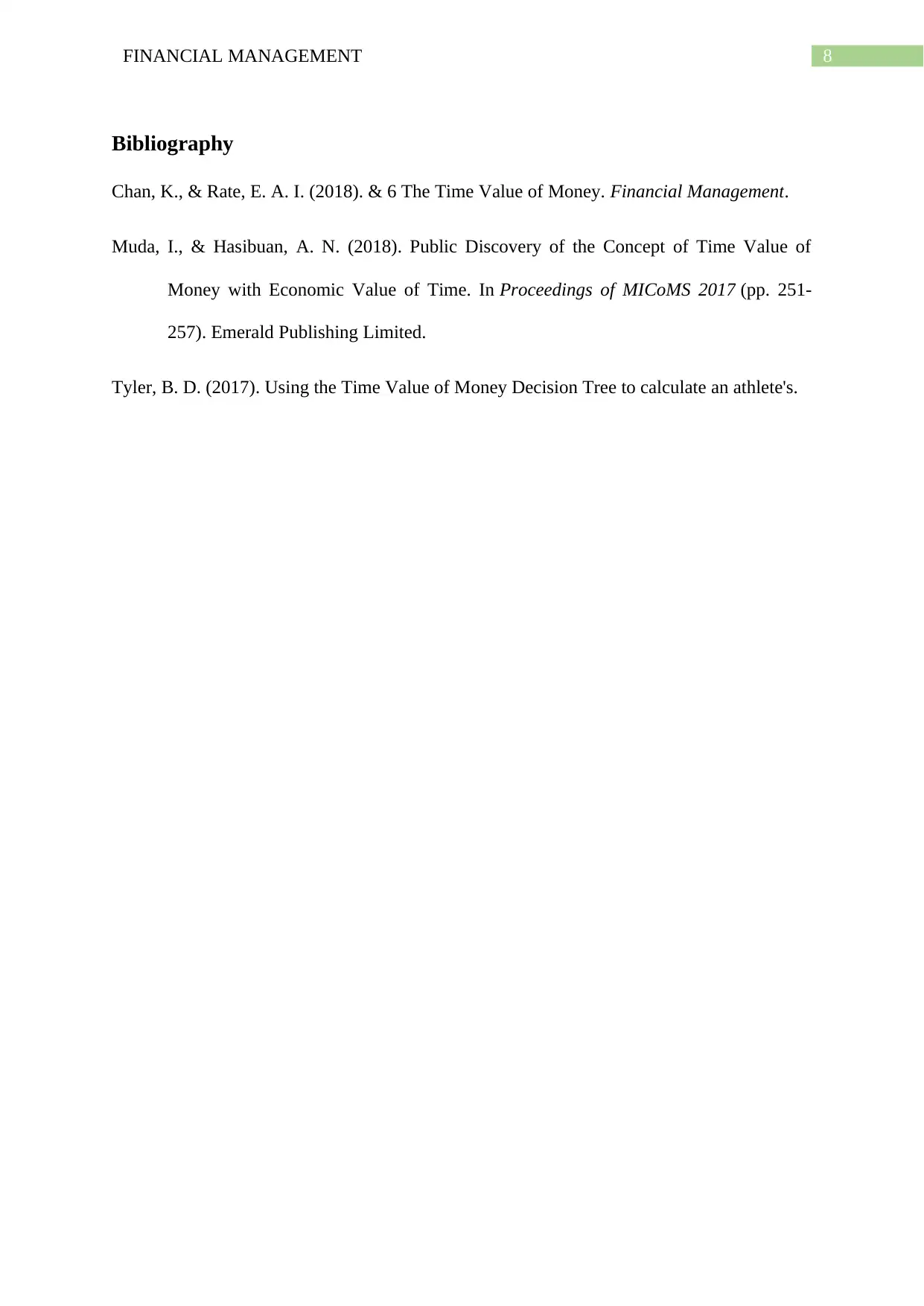
8FINANCIAL MANAGEMENT
Bibliography
Chan, K., & Rate, E. A. I. (2018). & 6 The Time Value of Money. Financial Management.
Muda, I., & Hasibuan, A. N. (2018). Public Discovery of the Concept of Time Value of
Money with Economic Value of Time. In Proceedings of MICoMS 2017 (pp. 251-
257). Emerald Publishing Limited.
Tyler, B. D. (2017). Using the Time Value of Money Decision Tree to calculate an athlete's.
Bibliography
Chan, K., & Rate, E. A. I. (2018). & 6 The Time Value of Money. Financial Management.
Muda, I., & Hasibuan, A. N. (2018). Public Discovery of the Concept of Time Value of
Money with Economic Value of Time. In Proceedings of MICoMS 2017 (pp. 251-
257). Emerald Publishing Limited.
Tyler, B. D. (2017). Using the Time Value of Money Decision Tree to calculate an athlete's.
1 out of 9
Related Documents
Your All-in-One AI-Powered Toolkit for Academic Success.
+13062052269
info@desklib.com
Available 24*7 on WhatsApp / Email
![[object Object]](/_next/static/media/star-bottom.7253800d.svg)
Unlock your academic potential
© 2024 | Zucol Services PVT LTD | All rights reserved.





